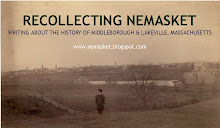In the late 1800s, a modified version of the Grube Method of teaching arithmetic was employed in Middleborough schools, including the Green. “By this method the four fundamental rules, together with fractions, are simultaneously taught....All the combinations and separations are taught simultaneously by the use of objects, instead of dwelling on addition till it is mastered, then proceeding to subtraction.”
All instruction in arithmetic was strictly oral until the 5th grade when the first text – White’s Elementary Arithmetic – was introduced. This same text was utilized for 6th grade students as well. Scholars in the subsequent three levels used White’s Complete Arithmetic. While White’s comprised the standard arithmetic text for Middleborough pupils, in 1884, the school committee noted that “there is a new and much better edition of White’s Arithmetic, issued since their introduction into town. The change must come sooner or later….” Textbook work was supplemented by “extra work upon the black-board taken from different arithmetics and original work by the teachers."
Success in arithmetic at the time was measured how rapidly and how accurately students could calculate. In this regard, Superintendent Fitts in 1887 felt that local schools lagged behind those elsewhere and consequently sought an improvement in this area.
In January, 1898, the school department formalized a “Course of Study in Arithmetic” for the elementary schools which urged that “accuracy and rapidity should be thoroughly cultivated” while “long and complicated problems should be avoided”. Students were introduced to simple multiplication, division and fractions as early as the first grade, while simple geometric problems such as calculating surfaces and volumes was introduced in the 5th grade.
The intention of the school committee that the course prove of practical use was indicated by the fact that 5th graders also learned simple business forms such as bills, receipts and promissory notes, and would continue to study these items through the remaining grades when accounting principles were added. Algebra was studied in the 9th grade until 1904 when it was dropped from the grammar school curriculum in order to provide more time for arithmetic. Typical arithmetic problems taken from White's New Complete Arithmetic (1883) indicate the practicality of the subject:
A dairy of 10 cows yielded in one season 120 Hl of milk and 450 Kg of butter; the milk was sold at an average of 6 1/2 cts. per liter; and the butter, at 56 cts. per kilo: what were the season's receipts in money?
How many yards of Brussels carpeting will carpet a flight of stairs consisting of 18 steps, including the landing, each step being 10 in. wide and 8 in. high, if 1 1/4 yards be allowed for turnings? What will be the cost at $2.25 per yard?
Smith & Jones bought $500 worth of goods on 4 months' credit, $700 on 6 months' credit, and $1000 worth on 5 months' credit: what is the equated time for the payment of the whole?
In 1906, Superintendent Bates recommended that arithmetic no longer be taught in the first grade in order that more time could be devoted to reading, writing, language, music and drawing. Such a recommendation was consistent with educational practice in a large number of schools. 1910 saw the reduction of abstract arithmetical work in the lower grades.
In 1940, a new course of arithmetic study was approved for the first three grades and introduced into the local schools including the Green.













+-+Copy.jpg)

+of+Smoky+Mountains+018.jpg)
No comments:
Post a Comment